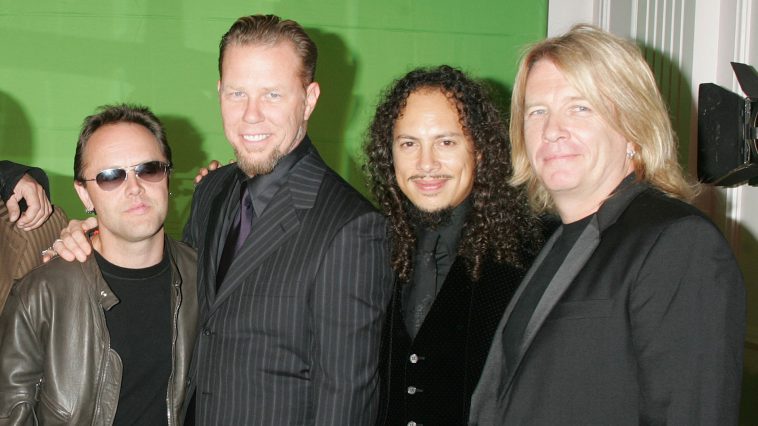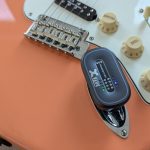Though revered record producer Bob Rock is mainly a guitarist, back in 2001 he boldly stepped into one of the most formidable bass gigs in rock: holding down the low-end with Metallica. Following Jason Newsted’s departure, Rock kept the iconic metal group’s album plans alive by playing all the bass guitar parts on its 2003 Elektra release, St. Anger.
Rock played just three gigs with drummer Lars Ulrich, guitarist Kirk Hammett, and vocalist James Hetfield, but in the studio he became an essential part of Metallica’s bass legacy. “Please – tell all the bass players of the world to be easy on me, man,” Rock told Bass Player. “I did my best to represent you well!”
With a history of powerhouse rockers like Newsted and founding Metallica bassist Cliff Burton – who died in a 1986 tour bus accident – Rock had big leather boots to fill. Fortunately, his own resumé would be enough to give anyone the confidence to step up and hammer it down.
In the early ’80s, Rock played guitar in the Payola$ before becoming one of rock’s most in-demand producer/engineers, helming hit albums by Loverboy, Mötley Crüe, Aerosmith, Bryan Adams, Bon Jovi, and the Cult.
Rock has worked closely with Metallica since the band’s self-titled 1991 Black Album, a sonically intense record that brought the band widespread mainstream success with tracks like Enter Sandman and Nothing Else Matters.
Metallica – Enter Sandman Live Moscow 1991 HD – YouTube
Watch On
Though Rock admits he had “never really played bass” aside from his own demos, his willingness to give it a go meant work on St.Anger wouldn’t have to wait for a permanent bass replacement.
“Years ago Lars, James, and I were going through a song we did for the Mission Impossible soundtrack [I Disappear], and I played bass because Jason wasn’t there. So after Jason left the band, rather than go through the ordeal of auditioning bass players, they said, ‘Why don’t you just play bass like you did on the Mission Impossible thing?’ It was at the album’s beginning stages, and it basically stuck.”
All the latest guitar news, interviews, lessons, reviews, deals and more, direct to your inbox!
Was it nerve-racking to play bass with Metallica?
“The great thing was that I had no aspirations to join the band, so I didn’t have anything to lose. They’re close friends of mine and we’ve got a great relationship, so it was a great position to be in. The guys who auditioned had a lot to think about, but if I screwed up or if it didn’t work out, it wasn’t a big deal. Therefore I was free to do whatever I wanted, and luckily enough, it worked.”
How did you approach playing on St. Anger?
“I know what I like to hear on bass, so it was a matter of just executing it. The big difference on that record as a whole is that I tried to define the bass in more of a classic role of working with the drums rather than going with guitar. At every opportunity I concentrated on staying with Lars.
“I like to serve the song, no matter what. Because I’m more of a guitar player, I can’t play that fast with my fingers, but for certain sections, maybe when it was more spacious, I’d drop the pick and play fingerstyle to get more of a reggae feel. I’d change up to serve the section of music. My approach was definitely one of no ego. It wasn’t about playing my personal style.”
Metallica – Frantic (Official Music Video) – YouTube
Watch On
How is that different from the way Jason would have approached it?
“When I met Jason he was very much into what I consider traditional heavy metal bass playing, where the bass follows the guitar to strengthen it as one solid riff. We tried to give him a little more room to act as a rhythm player.
“For the few gigs I did with Metallica I had to learn some of the Cliff Burton stuff, and that really gave me a chance to appreciate what Cliff brought to the band as well. That definitely influenced the way I approached the bass, too.
“Cliff sometimes played the role of following the guitars, but in other opportunities he broke away and did counter kinds of things. Also, Lars was into breaking away from traditional metal drumming, so the rhythm section had more of a straight-ahead feel.”
You’ve had a unique opportunity to get inside the styles of all of the Metallica bass players. Do you feel there is a specific bass role in the band?
“It has evolved. Cliff was really the bass player for Metallica. With his unfortunate passing, Metallica has gone through other players – Jason, myself, and now Rob Trujillo and each one of us has added something to the music.”
(Image credit: Photo by Tim Mosenfelder/WireImage)“With Jason, I always tried to get more of a classic, bass-drum approach where the bass is a rhythm instrument and sometimes counters the guitars. That’s kind of what Cliff brought to the band. But since he was one of the forming members, in their eyes, he was always kind of even with them.
“When Jason came along, I don’t know if they gave him the same room as Cliff in the sonic picture. Through working with Jason, I think they now appreciate the value of the bass. The guys in the band have learned to enjoy that.”
How did you work in the studio?
“Our work consisted of four guys just jamming in a warehouse for ungodly hours. The drums and the bass were played live together with the guitars all in the same room, with leakage everywhere. The entire album is basically snippets of those jams put together in Pro Tools to form songs.
“We’d use the same approach for lyrics; rather than James taking the song away and trying to get an idea and doing it himself, I’d make him write the song in 15 minutes so it was almost a single stream of consciousness.”
Metallica: Some Kind of Monster (Official Music Video) – YouTube
Watch On
“Then, the four of us would sit down and everybody would get involved. We’d talk about the song’s subject and give input, and then James would piece it all together. We would come up with a song by that night.
“Overall we probably had 45 song ideas over 18 months, and when one seemed like it was special, we’d keep the basic song theme and expand on that. We just kept working in that fashion until we were satisfied with the whole thing. We tried to use this approach across the board with as much purity as possible.”
What instruments did you play?
“I have a collection of vintage basses that I’ve had for production – Precisions, Jazz Basses, all sorts of stuff – but the one bass I wanted to get hold of belonged to Scott Smith from Loverboy, who sadly passed away.
“Scott had one of the first Spectors ever made, and it has this weird triangle pickup in it. He used it on the first two Loverboy albums, and it was amazing, so I contacted his family and they let me use it on the album. I tried everything, but this bass just ended up being the one – and it worked out great.
“I used a vintage Ampeg SVT rig with an 8×10, and an old Marshall Superbass 100-watt head with some 4×10 cabinets for distortion. There were three tracks of bass: a DI, the SVT, and the Marshall. I’d plug into a transformer DI made by one of the techs at a studio I used to work in; from there I went into a SansAmp and a Dunlop wah, and then I split that off into the SVT and the Marshall.”





GIPHY App Key not set. Please check settings